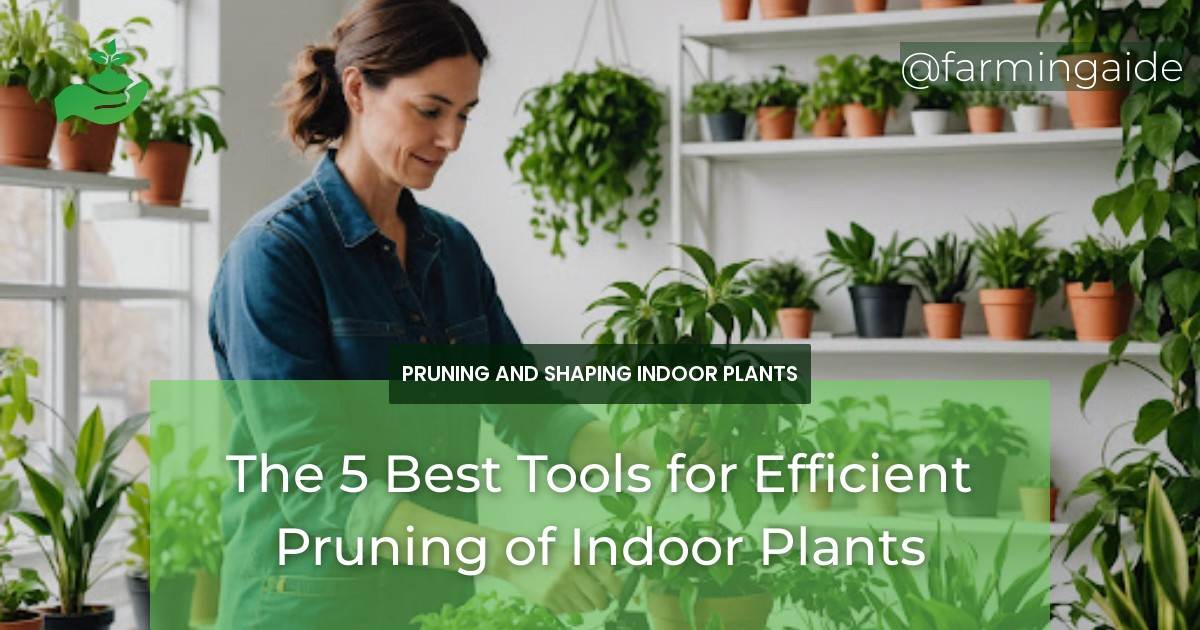As an indoor gardener, you understand the importance of pruning your plants to maintain their health and appearance. However, choosing the right tools for the job can be overwhelming, especially for beginners. In this article, we’ll explore the top 5 tools for efficient pruning of indoor plants, as well as provide tips on how to choose the right tool for your plant, maintain your tools, and enhance your indoor gardening experience.
Key Takeaways
- Discover the top 5 pruning tools for efficient indoor plant pruning
- Learn the importance of pruning and basic pruning techniques
- Understand how to choose the right tool for your plant type
- Get tips on maintaining and caring for your pruning tools
- Enhance your indoor gardening experience with efficient pruning
Introduction to Indoor Plant Pruning
Pruning is an essential part of indoor plant care, as it helps maintain the plant’s shape, promotes healthy growth, and encourages blooming. However, many indoor gardeners are unsure about the best tools to use for pruning, leading to ineffective pruning techniques and damage to their plants.
In this article, we’ll explore the importance of pruning, basic pruning techniques, and the top 5 tools for efficient pruning of indoor plants. Whether you’re a beginner or an experienced indoor gardener, this article will provide you with the knowledge and skills to take your pruning game to the next level.
Importance of Pruning Indoor Plants
Pruning is essential for maintaining the health and appearance of your indoor plants. It helps to:
- Promote healthy growth and development
- Encourage blooming and fruiting
- Maintain the plant’s shape and size
- Remove dead or diseased branches
- Improve air circulation and reduce disease risk
Basic Pruning Techniques
Before we dive into the top 5 pruning tools, it’s essential to understand basic pruning techniques. Here are some tips to get you started:
- Always use clean and sharp tools to prevent spreading diseases
- Make clean cuts at a 45-degree angle, just above a node
- Remove any dead, diseased, or damaged branches
- Prune during the plant’s dormant season for best results
Top 5 Pruning Tools for Indoor Plants
In this section, we’ll explore the top 5 pruning tools for efficient indoor plant pruning. From precision pruning shears to adjustable pruning saws, we’ll cover the best tools for the job.
ALSO READ
Tool 1: Precision Pruning Shears
Precision pruning shears are ideal for trimming small branches and stems. They’re perfect for delicate plants that require precise pruning.
Features:
- Sharp, high-carbon steel blades
- Ergonomic handles for comfortable grip
- Adjustable tension for customized pruning
Tool 2: Compact Loppers
Compact loppers are perfect for thicker branches and stems. They’re ideal for pruning larger indoor plants that require more force.
Features:
- Strong, forged steel blades
- Comfortable, non-slip grips
- Compact design for easy storage
ALSO READ
Tool 3: Micro Snips
Micro snips are perfect for precision pruning of small stems and delicate branches. They’re ideal for plants that require intricate pruning.
Features:
- High-carbon steel blades
- Ergonomic handles for comfortable grip
- Compact design for precise pruning
Tool 4: Crevice Tools
Crevice tools are designed for pruning in tight spaces. They’re perfect for plants with dense foliage or hard-to-reach areas.
Features:
- Long, curved blades for reaching tight spaces
- Comfortable, non-slip grips
- Adjustable tension for customized pruning
Tool 5: Adjustable Pruning Saws
Adjustable pruning saws are perfect for thicker branches and stems. They’re ideal for pruning larger indoor plants that require more force.
Features:
- High-carbon steel blades
- Adjustable blade angle for customized pruning
- Comfortable, non-slip grips
Choosing the Right Tool for Your Plant
When choosing a pruning tool, it’s essential to consider the type of plant, branch size, and desired outcome. Here are some factors to consider:
- Plant type: Delicate plants require precision pruning shears, while larger plants require compact loppers or adjustable pruning saws
- Branch size: Thicker branches require more force, while smaller branches require precision pruning
- Desired outcome: Consider the desired shape, size, and health of your plant when choosing a pruning tool
Factors to Consider When Selecting Pruning Tools
When selecting a pruning tool, consider the following factors:
| Factor | Description |
|---|---|
| Plant type | Consider the type of plant, its size, and growth habits |
| Branch size | Choose a tool that can handle the branch size and thickness |
| Desired outcome | Consider the desired shape, size, and health of your plant |
Matching Tools to Plant Types
Here’s a guide to matching pruning tools to plant types:
| Plant Type | Recommended Tool |
|---|---|
| Delicate plants | Precision pruning shears or micro snips |
| Larger plants | Compact loppers or adjustable pruning saws |
| Dense foliage | Crevice tools |
Maintenance and Care of Pruning Tools
Proper maintenance and care of your pruning tools are essential for their longevity and effectiveness. Here are some tips:
Cleaning and Sharpening Pruning Tools
Clean your pruning tools after each use to prevent rust and bacterial growth. Sharpen your tools regularly to maintain their effectiveness.
Storing Pruning Tools Properly
Store your pruning tools in a dry, clean area, away from direct sunlight. Use a tool sharpener or storage case to protect your tools.
Conclusion: Enhancing Your Indoor Gardening Experience
Efficient pruning is essential for maintaining the health and appearance of your indoor plants. By choosing the right pruning tool for your plant, maintaining your tools, and following basic pruning techniques, you can enhance your indoor gardening experience and enjoy thriving, beautiful plants.
Remember, pruning is an art that requires patience, practice, and the right tools. By following the tips and guidelines outlined in this article, you’ll be well on your way to becoming a pruning pro and enjoying the many benefits of indoor gardening.


